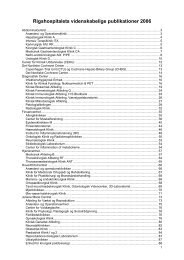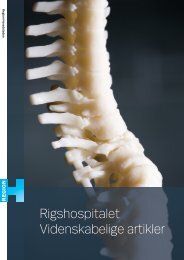View - CTU
View - CTU
View - CTU
You also want an ePaper? Increase the reach of your titles
YUMPU automatically turns print PDFs into web optimized ePapers that Google loves.
table 10. In the 'technical<br />
-filling quality and in the<br />
Tionest.<br />
1 the best technical result,<br />
: was found not guilty. In<br />
of the involved teeth were<br />
i if the root canal anatomy<br />
efective, apical pathology<br />
:ase was the absence or<br />
11 Complaint Boards.<br />
ttlement Rejection Total n (%)<br />
2 44 (32.1)<br />
16 (11.7)<br />
9 (6.6)<br />
4 (2.9)<br />
12 (8.B)<br />
23 (16.81<br />
12 (8.8)<br />
14 (10.2)<br />
3 (2.2)<br />
Sex differences between GDPs<br />
The female GDPs took significantly more time (Study II) than the males for all<br />
procedures (access cavity, mechanical root preparation, root filling), as expressed by<br />
the positive y-coefficients (Table 4 ). Moreover, female GDPs more often scored the<br />
following factors as being important for the outcome of endodontic treatments: 'tooth<br />
type','fever', 'localized swelling' and the presence of a 'fistula', all other matters being<br />
equal (Study V). Technological advances such as apex locators were more<br />
frequently used by males than by females. Males had also more frequent endodontic<br />
sessions per week than females (Study V). In general, males had a perception of a<br />
satisfactory level of endodontic knowledge, and males made satisfactory self-report<br />
about their clinical skills more often. Other findings could contradict these·<br />
perceptions. For example, the 'periapical status' as a preoperative prognostic factor<br />
was underestimated by the males as compared to the gold standard and to the<br />
females (Study IV). In addition, males were more likely to receive an endodontic<br />
claim (Study VI). Male dentists were involved in 69% (n = 331) of the endodontically<br />
related complaints, which differed significantly (P < 0.0005; x 2 =15.189) from the<br />
general proportion of male GDPs (57.8%) during the period. In contrast, the majority<br />
of complainants were women (71.0%, n = 342), which differed significantly (P <<br />
0.0001; x 2 = 77.543) from the general proportion of females (50.8%) among patients<br />
who received root canal treatment within the same period (Study I).<br />
3 137 {100.1)<br />
reel treatments" and the DCB<br />
y VI. Reprinted with permission<br />
vas noted in the 'technical<br />
1ent' group (13.5% ).<br />
33








